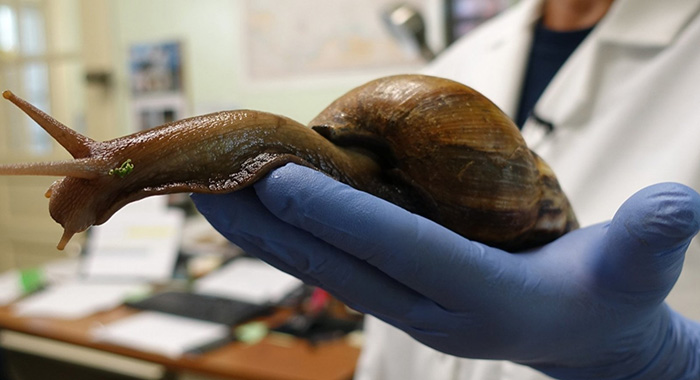St. Vincent and the Grenadines has launched an eradication programme for the giant African snail, an agricultural pest that spreads disease-causing parasites to humans, which has been confirmed as present in the country.
The snails eat a variety of agricultural produce, including peanuts, beans, peas, cucumbers and melons among 500 types of plants.
They also would eat a variety of ornamental plants, tree bark and even paint and stucco on houses, if fruits and vegetables are not available and can carry a parasite that can lead to meningitis in humans
In a statement to Parliament on Thursday, Minister of Agriculture, Saboto Caesar said that the ministry had completed an investigation concerning the presence of a snail population between Camden Park and Ottley Hall, two communities west of Kingstown.
“The photographs of the snails were sent to the United States Department of Agriculture, the USDA, through the Caribbean Plant Health Directors mechanism for identification.
“The USDA officials confirmed on Monday the 10th of July 2023 that the snails currently being collected in the affected areas are indeed the giant African snails. With this confirmation, the Ministry of Agriculture, Forestry, Fisheries, Rural Transformation, Industry and Labour can now officially declare the Giant African Snail to be a pest locally,” Caesar said.
He told lawmakers that the Ministry of Agriculture has activated its surveillance programme nationwide.
The minister said giant African land snail is a common name for several species of large snails endemic to different regions of the African continent. The larger species can grow up to 30 centimetres in length and 15 centimetres in diameter.
“These snails are herbivores that feed on a variety of plants, fruits, nuts, and flowers. They can also eat smaller invertebrates to satisfy their calcium and protein requirements,” Caesar said.
“In regions where calcium carbonate lime-based materials are used in construction. These snails have been known to consume portions of the exterior walls in search of calcium, potentially impacting physical infrastructure in urban and suburban areas.”
The minister explained that giant African snails propagate at a very fast rate once they infest a suitable habitat.
“These snails multiply quickly. Each mature snail can live up to 1,200 eggs per year and have few natural enemies to curb population numbers.
“As such, they present a risk of exponential expansion once they gain a foothold in a new region,” Caesar said, adding that the snails thrive in tropical and subtropical climates, and are believed to have been introduced in the Caribbean in the 19th century through the plant trade.
“Since that time, the snails have infested several territories including Jamaica, Puerto Rico, the Dominican Republic, St. Lucia, Martinique, Barbados, and other territories in the Caribbean.”
The minister said it is difficult to estimate precisely when and by what means these snails were first introduced to SVG.
“Continued monitoring of the affected areas and neighbouring regions may provide additional context in this regard and the investigation continues,” Caesar said.
“The giant African snail poses a severe threat to agriculture in the Caribbean. It consumes a wide range of crops, including fruits, vegetables and ornamentals.
“The giant African snail also presents public health concerns to individuals in the affected areas. It can serve as an intermediate host for parasitic worms.”
Caesar said the first report of the snails came on June 29 from the Camden Park and Questelles area, in south western St. Vincent, which remains the region most heavily infested with the snails.
On July 11, snails were confirmed present on the premises of the Ottley Hall Marina, just west of the capital.
“Despite ongoing surveillance in the surrounding areas, no additional spread of the infestation has to date been observed,” Caesar told Parliament.
“Officers from the Plant Protection and Quarantine Department, which has been fulfilling the lead role in the ministry’s surveillance and removal efforts, reported on the 7th of July to the Cabinet that a total of 1,000 Snails had been removed from the affected areas. By the 9th of July, the department updated this number to 4,000,” Caesar said.
The minister said Caribbean countries have implemented various strategies to control and manage the infestation of the giant African snail which collectively form a best practice for the region.
These measures include public awareness and education, quarantine measures, biological control, chemical control, monitoring and surveillance.
“The Ministry of Agriculture has created a comprehensive work plan to respond to the local infestation based on the regional best practices as implemented by an inter-agency task force.
He said the Cabinet has authorised the establishment of the Inter-Agency Task Force for the Eradication of the Giant African Snails, headed by Jean-Saville Cummings, who holds a doctorate in molecular medicine.
“The agency is represented and comprised of several different ministries, organizations and entities that will be working together. It is hoped that this expansive response to the management of the invasion will allow SVG to become among the first territories to successfully eradicate this pest from within its borders.,” Caesar said.
He said that the Ministry of Agriculture is also advising the public to avoid direct contact with the snails.
“Avoid crushing live snails. Destroy the snails by placing them in salt water solution in a covered bucket for 48 hours. Bury dead snails. keep the surroundings clear and clean of garbage, which may provide suitable conditions for snails and avoid consuming the snails as they may be a source of infections,” Caesar said.







These Giant African Snail are also in Cane Garden they were first spotted in February 2023.
They comes out at nights and they move at faster than the ordinary snail.Unfortunately because we were on vacation at the in SVG we did not know that it was matter needed to be reported we became aware of them while sitting on the porch chatting with a friend and notice he kept on adjusting his shirt collar it was then I saw the first Snail, we started to look to see where it came from and noticed several more climbing up the wall and also on the tomato plants, we just throw salt on them and chopped them up. During the day there are not even one in sight but they comes out at nights.
So how, when and where did this snail enter SVG. These are important questions that should be investigated to stop the importation. Just removing what’s there now is not the only answer.
This is very alarm and concerning and the government in a whole with the agriculture department should take this situation seriously and investigate how and when this insect arrived in SVG?.
I am wondering if there’s other insect from Africa is in SVG . If the country can have such insect there’s other probability that the country is prone to other insect
There’s a sluggs infestation, maybe the same snails. In spring biabou. (shipping bay).
And entire large plot of land that’s presently in bush, these creatures are seen by the hundreds. On any given night.
The matter been reported to Agricultural Officer and no one ever respond.